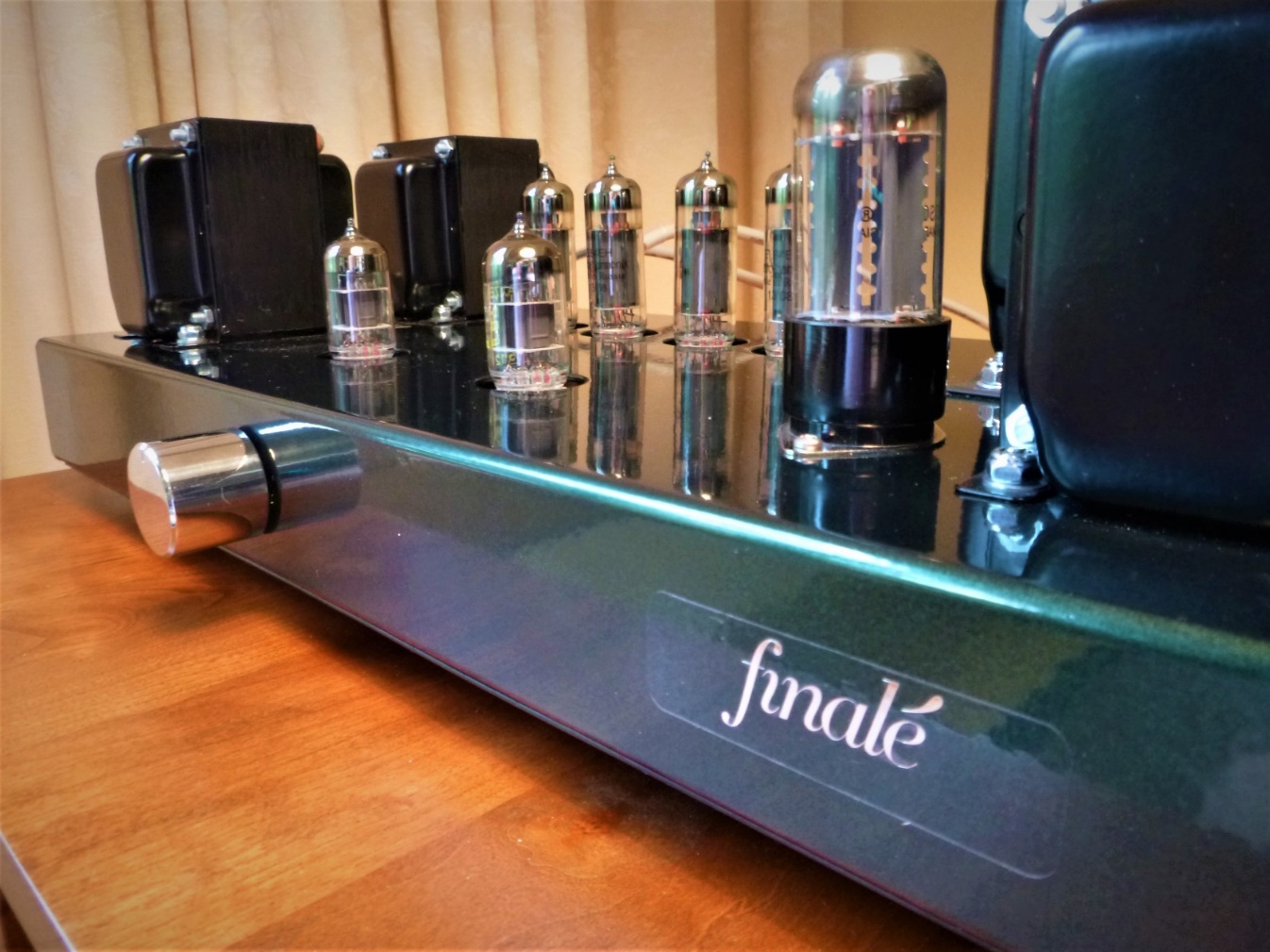Finalé Audio F-7189 II Integrated Amplifier: Watch out old Dynacos, there’s a new EL84 amp in town.
Review by Steve Graham
Did Finalé Audio just pick the model number for their revised EL84 amplifier out of the air? Not quite. If you know your tube history – yeah, I know, yawn – a 7189 tube is an obscure, uprated EL84, one that could be run harder and therefore output a bit more power. For background on the EL84 and the 7189, try this link. (PDF file)
Does the world really need another EL84 amplifier? Why not, you’d have to try really hard to make an EL84 amplifier that sounds bad. But does the F-7189 II stand out from the crowd?
But First
Finalé Audio and and its sister company, Triode Lab Ltd., are Canadian builders of tube power amplifiers as well as tube and hybrid preamps. Amplifiers are sold under the Finalé and Triode Lab banners. Finalé Audio is in the process of rationalizing and refocusing their line of amplifiers and offering them through select retailers. The plan is to move the brand a bit more mainstream without compromising performance. To streamline the production process, simplify stocking and ensure timely delivery there will be one standard chassis colour – metallic racing green. Finalé is committing to maintaining stock, in the aforementioned green, of all chassis in their amplifier lineup. This will ensure fast turnaround as usually the chassis is the long lead time item in the production process. As in the past, buyers may have custom colours, different output transformers and some customisation of passive components if they wish, though this will likely result in longer delivery times. As long as metallic green is acceptable, a maximum twenty day factory turnaround is Finalé’s aim. If more extensive customization is desired, a Triode Lab amplifier might be the preferred way to go. If you fall in love with a dealer’s Finalé demonstration unit, buying it, for a bit of instant gratification, may be a possibility.
The F-7189 II
The amplifier I reviewed was a prototype. (There wasn’t a serial number on the unit) I was told that this very amplifier will be on display at the Toronto audio show this coming October. All the same, it looks like a finished, or nearly-finished design. I’m told production models will be more accommodating for users by incorporating multiple, switch-selected, inputs. Users won’t have to play cable jockey when changing sources.
Me, I’d be happy to have a power switch on the front, or at least the side instead of on the back, where most Finalé power switches seem to reside. Oh, and a LED to show when the unit is on would be nice. If I was in a real bloody-minded mood, I’d insist on a big jeweled pilot lamp like the ones seen on guitar amps. I mean, is an easily accessible power switch and a LED too much to ask for?
These quibbles aside, the chassis looks very nice, painted flawlessly inside and out in the stock metallic green. If ordering a custom version, I’d insist on having the transformers and power supply choke painted the same colour as the chassis. A paint upgrade over the basic Hammond black would make the amp look more appealing and send the pride of ownership factor up several notches.
If I’m being over-critical, it’s only because I really want Finalé to raise the functionality and cosmetic appeal of their amplifiers. The F-7591 I reviewed last year, and this review’s F-7189 II both have sound quality that deserves better ergonomics and eye appeal. In some circles it’s seen as uncool to suggest that HiFi gear should be user friendly, and should encourage audio lust. Call me shallow if you wish, but I don’t buy into the hair shirt approach.
And while I’m in this bitchy mood, the Finalé website could use a significant makeover too. At first glance, the website looks nice but a bit of digging leaves one with the impression that some bits have been tacked on. Sometimes, there is more than one amp pictured in an amplifier’s description. A professional redo is long overdue.
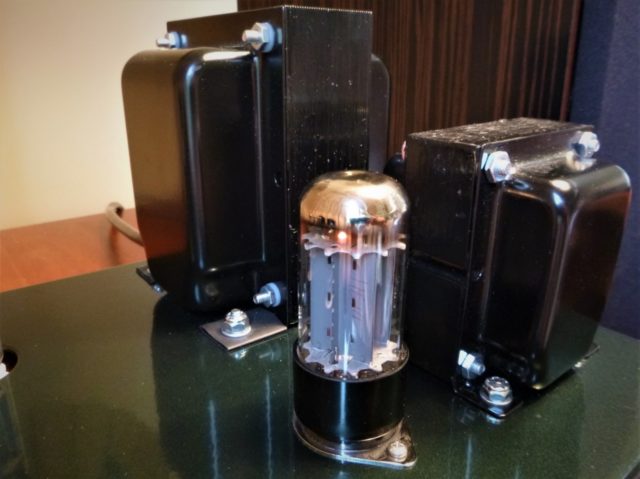
Back to the amp. Just upstream from the awkwardly positioned on-off switch is the power transformer. A physically and electrically larger unit is employed than typically seen on most EL84 amps. HT voltage is rectified by an ever-green GZ34/5AR4 tube. One advantage to using this particular tube is that it delays application of B+ to the rest of the circuit. This allows some warm-up time before HT voltage is applied. The delay may add to the longevity of the rest of the amplifier’s components. The power supply also contains a large filter choke. Both the tube rectifier and choke, not normally seen on EL84 amps, are more often employed on higher-powered and more feature-laden amplifiers.
The input jacks go straight to the volume control and then to a 12AX7 tube. One section of this dual-triode supplies the voltage gain, and the other half performs phase-splitting for the two EL84 tubes per channel, which are configured in push-pull. The output transformers (Hammonds on the review amp) are more generously specified than is typically seen in EL84 amps. Part of this over-specification is due to the 20 watt per channel output power. There is also, I sense, a general inclination on the part of the designer to ‘over-building’ on this amplifier.
The typical EL84 amplifier, running in ultralinear, is usually only capable of about 15 watts per channel. Two EL84’s, run in push-pull, can output 20 watts if two conditions are met: (1) rugged tubes are needed – most Russian-made EL84’s will stand this sort of abuse, and (2) they must be run in Pentode mode with a regulated B+ supply on the tube’s screen grids. The F-7189 II satisfies both of these requirements.
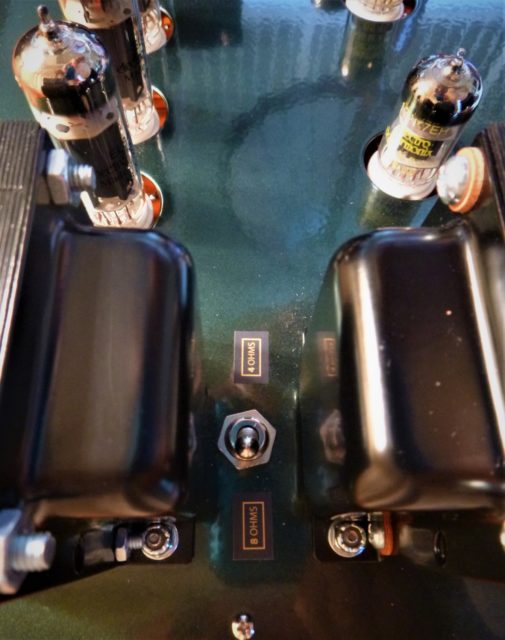
The output transformers are configured for 4 and 8 ohm duty, selected by a switch partially concealed between them. I’m a little suspicious of switches as a means to change impedance. Personally, I just don’t like another set of contacts in the signal chain. My skepticism was justified as at one point the right channel stopped working. Flicking the impedance switch a few times restored the signal. A better-quality switch is called for – or better still, in my opinion, three output terminals per channel. Common, 4 ohms and 8 ohms. The output connectors, though not especially noteworthy, are serviceable and, if memory serves, better than the ones on the F-7591 I reviewed last year.
If you want a bit more power, to the tune of 22 watts per channel as opposed to the stock 20, Hashimoto OPTs may be specified. (See below for this review’s “rant”, concerning transformers.)
A peek inside the chassis revealed a very neatly populated circuit board. Some very nice and somewhat pricey Mundorf capacitors triggered a moment of covetousness on my part.

Review System
I auditioned the F-7189 II in the system that plays in the great room of my home. Though it must energize a space of approximately 15,000 cu. ft. (425 cu. m.), my wife and I don’t listen at silly-high SPLs. It’s also a system that prioritises musical enjoyment over “audiophile” sensibilities. The front end consists of a Lumin D1 playing rips from CD’s, 24/192 needle drops from LP’s, and high-resolution downloads. The ancient Hafler normally used in this system was benched. Amplification duties were shared by the F-7189 II and a DIY EL84 amp based on the Dynaco ST-35 circuit. Vintage Dynaco output transformers, the kind gift from a friend, were the motivation behind the build of that amplifier, which normally resides in my workshop, powering a small pair of Wharfedale Diamonds. The workshop EL84 amp and the F-7189 II took turns driving Spendor D7’s I the great room. Ideally, the D7’s should have a bit more power than this. Their decent sensitivity and benign impedance curve enable them to play more loudly and without strain than many bookshelf and stand mounted loudspeakers. The Spendors, though not ruthlessly revealing, show no hesitation exposing differences in the components preceding them. Fifteen or twenty watts per channel is a bit marginal in this situation, so I didn’t push the amps too hard.
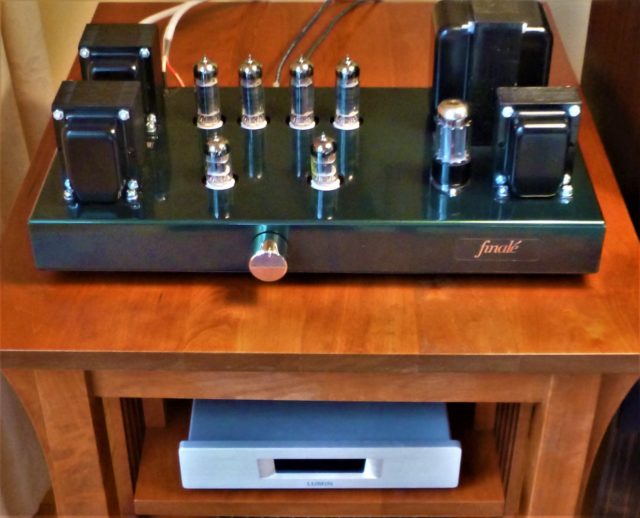
Tracks used for auditioning
Ella Fitzgerald and Louis Armstrong: These Foolish Things (CD rip)
Joe Cocker: Sweet Little Woman (CD rip)
Jimmy Clegg and Savuka: Dela (CD rip) (sad news dept: Jimmy Clegg passed away recently at a too-young 66)
Loreena McKennitt: Caravanserai (CD rip)
Bill Evans: You Must Believe in Spring (24/192 rip from LP)
KD Lang: MTV Unplugged (24/192 rip from LP)
Vaughan Williams: Tallis Fantasia (24/192 rip from LP)
Sound
In the bass there wasn’t much to choose between the two amps. Both seemed go about as low as the Spendors required. They also got an acceptably good grip on the Spendor’s woofers. It wasn’t the sort of domineering control that you might get from some solid-state amplifiers, but true audiophiles don’t live by bass alone. I have found, with the four Spendor models I’ve listened to in the past year or so, that none of them were that difficult to corral at low frequencies.
From the lower midrange through to the highest frequencies, the Finalé was the superior amplifier. This was dramatically apparent in the treble on the McKennitt track. At about the six minute mark of Caravanserai there is a triangle or small cymbal easily heard in the right channel. This instrument, struck about half a dozen times, was just purer, less mechanical and more realistic-sounding when amplified by the F-7189 II.
The piano notes on the Bill Evans album just seemed to “plink” out of the speakers in a wooden manner when reproduced by the Dynaco clone. The Finale presented Evans’ playing more like a smooth-flowing musical composition than just a bunch of mechanically reproduced notes.
The Ella and Louis vocals sounded more appealing and genuine with the Finalé amp in the chain. The F-7189 II enabled Ella’s voice to float out of the speakers more naturally. Even Satchmo’s growl was, if not exactly musical, more believable. In general, the Finale had a much more relaxed, and yet clearer and more vital flow of musical details. Even though it was smoother sounding overall, those details were more finely articulated, thus allowing better engagement on the part of the listener.
It was easier to become more enveloped in the Vaughan Williams Tallis Fantasia when heard through the F-7189 II. There was a better sense of the emotional sweep, the ebb and flow of the playing and the acoustics of the recording’s venue.
The Finalé might have been able to play a little louder without strain than the other amp. It’s difficult for me to say if it was more powerful, or if its more musical nature made it easier on the ears when turned up a bit louder than the Dynaco-based based amp.
All of the above is a relative assessment. In absolute terms, I found the F-7189 II, with the speakers and source used, a honey of an amplifier. It was musical, engaging and thoroughly enjoyable. It brought a higher level of enjoyment to all music played on my, or more accurately, my wife’s system. The old amp is no slouch, and sounds decent enough on its own, but the F-7189 II was clearly superior. The Spendor D7’s are a less taxing load than many other speakers. That being said, nobody is going to buy a F-7189 II to power a set of Wilsons.
So, am I going to ditch the old Dynaco based amp? No, it has been returned my workshop system and is more than adequate for that purpose. To be honest, it was built with some quite prosaic passive parts so I’m not surprised it was outclassed by the Finalé. I was however, more than a little surprised at how thoroughly the F-7189 II stomped all over the other amp.
As long as Finalé doesn’t mess with what’s good in this F-7189 II prototype, and addresses its easily rectified shortcomings, they should have a winner. If this revamp/renewal plays out across the full line of Finalé products, lovers of tube-based amplification will be the beneficiaries.
Conclusions
There are a few mechanical details Finalé needs to refine with this component, but these are an easy fix. With sympathetic source components and speakers, its quality of music reproduction should shine through.
Could this amp be for you? Admittedly, at $3,800 Canadian, it’s not going to be considered a bargain-basement amplifier. The Finalé F-7189 II is a perfectionist audio item and as such delivers the musical goods, as far as I was able to tell. For this money, a more mainstream EL34 or 6550-based amp might be considered. However, if a higher-powered amp is not needed, and especially if you listen to music many hours a day, replacing the EL84’s in this amp can seem almost cheap compared to a retube of higher-powered amps. The best EL34’s, in my opinion, are Gold Lion (re-issue) KT77’s at $50 US each (see my tube comparison). Four KT77’s plus tax and shipping will set one back about $320 Canadian. Ouch! Four Electro-Harmonix EL84’s, as used in the F-7189 II, will cost less than 100 bucks Canadian, tax and shipping in.
The F-7189 II was not likely ideal for the system I used for auditioning. It would be better suited to a system in a smaller room, or speakers with higher than average sensitivity. One of the Coherent models, or a mid-level Klipsch comes to mind if filling a big room at high SPLs is necessary. As with any high- or highish-sensitivity speakers, try them with any amp(s) you are thinking of purchasing to ensure the components preceding the speakers have a sufficiently low level of noise.
If, after a serious audition, you decide to take the plunge and order a custom F-7189 II, be sure to insist on a big, old-school, jeweled pilot light, mounted proudly on the front panel. If the Finalé people balk, then insist on a LED at the very least.
Finalé Audio F-7189 II Integrated Amplifier
MSRP: $3,800 CAD
Web: http://www.finaleaudio.com/
Thanks again to Peter Wolter, proprietor of Being There Audio in Orangeville, Ontario, for the loan of the F-7189 II http://www.beingthereaudio.com/
This Review’s Rant: Transformer Tales
Transformers 1
Transformer snobbery. Exotic sounding names from faraway places must be better. Some, including those who frequent the DIY audio forums, look down their noses at Hammond transformers. Wouldn’t you rather have a transformer with an exotic-sounding name in a nice case with a gold badge on top? It must be better, right? Maybe everyone, and not just Canadians, find the foreign more appealing. But before you berate the Hammonds used on the F-7189 II, be aware that Shindo imports exotic transformers – Hammonds, from Canada – for their Montille CV391 amplifier! Which, by the way, sells for about $7,000 US. I’m given to believe that most Shindo power amps, the models higher up the pecking order than the Montille, use Lundahl output transformers. I’m also not so naïve to suggest that using Hammond, Hashimoto, Lundahl or any other brand of transformer is a guarantee of, or precludes having good sound reproduction. The same goes for expensive capacitors or other passive parts. It’s the implementation that matters. You can’t throw a bunch of exotic parts at a poor circuit and expect to have decent sound. Like a stereo system as a whole, there must be balance. I’m not suggesting transformers don’t make a difference, I found quite the opposite with the Elekit TU-8340VK.
As always, we must have open minds before we open our ears.
Transformers 2
Transformer Ratings. One thing we can assume with some certainty is that power capacity, or more accurately the ability to transfer full bandwidth power to loudspeakers, is almost directly related to transformer size. They best way to judge power handling is by weight and physical size, at least for common EI core transformers. The Hammonds used in the F-7189 II are rated to deliver 25 watts from 30Hz to 30Khz. They weigh 4 pounds each.
In my hoard of transformer “iron” I have one pair from an amp that was rated to deliver 50 watts. These weigh 4 pounds, 9 ounces. I doubt that they’d do 50 watts from 30Hz to 30Khz. 25 to 30 watts max would be my guess.
Another pair of transformers, donors from an ancient Heathkit 25 watt per channel amp, weigh in at 5 pounds each. These will make the starting lineup for an amp to power my wife’s system, a project for next winter.
Now, suppose you are perusing a power amp of the tubed variety that is rated at say 15 to 20 watts. If you can nearly hide its output trannie in your hand, as shown immediately below, I’d bet money you won’t get much, well-controlled, bass power.
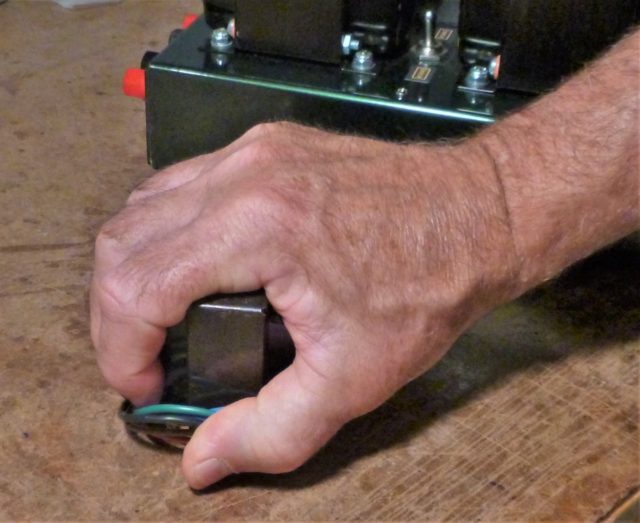
Below you see the same hand trying to cover one of the sensibly-rated transformers in the F-7189 II.
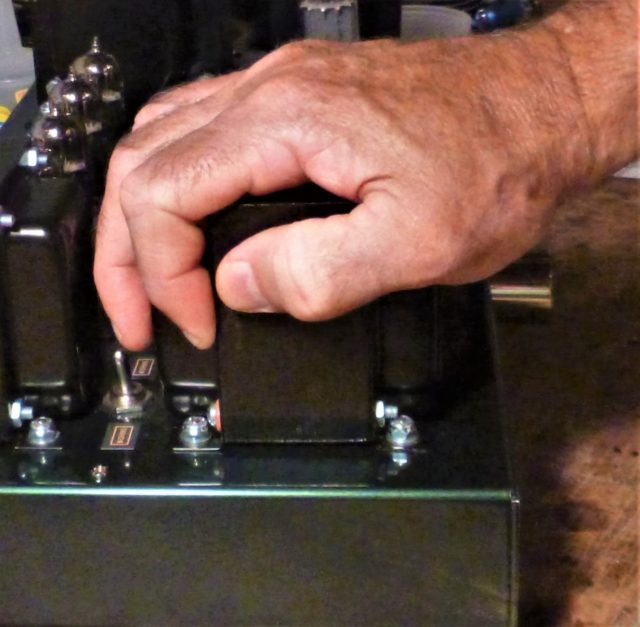
Metal is sold by the pound but shipped by the ounce. Good, appropriately sized, transformers don’t come cheap.
Review Disclaimers: Noam Bronstein, Owner/Editor of Wall of Sound, has also become a Finale/Triode Lab dealer, since November 2018. Noam had no input on this review, which was arranged between Steve and Peter.

